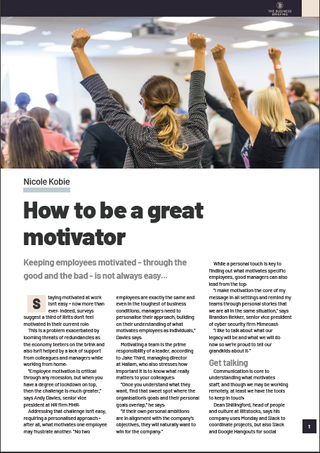How to make great decisions quickly
There's a difference between rushing and being decisive. Here are some tips on how to make the right choices when you can't afford to linger

2020 hasn’t been a year for dilly-dallying around. IT leaders have had to make crucial decisions at rapid speed and digital transformation projects that might have spent a large amount of time in gestation have been pushed through in days rather than years.
Research from consultancy firm McKinsey suggests about 70% of European executives believe the pandemic is likely to have accelerated the pace of their digital transformation. Companies have embraced the cloud, switched their workers from office to home, and boosted their e-commerce channels to keep serving their customers.
In many ways, necessity was the mother of invention: Companies had to make these rapid choices or risk losing a competitive advantage. However, making great decisions quickly isn’t just important during a pandemic. Executives who make smart decisions rapidly can help their businesses to not just survive but to thrive in the post-COVID age.
So, what’s the key to making decisions quickly? How can CIOs make great choices rapidly that improve the situation for the business, its employees and its customers? For Mark Gannon, director of business change and information solutions at Sheffield City Council, the answer lies in building trust across the organisation.
“Be honest about what you know and what you don't know, and then bring other people into that conversation. Trust your people and build a team where you know people feel able to ask questions that might seem stupid to them,” says Gannon, who says his method of effective decision making relies on the level of trust he builds.
“I very rarely make decisions; what I do is I ask questions,” he says. “So, somebody will come to me and they won't know what to do. However, really they do know what to do. What they want is somebody just to talk about it, and clarify what they're already thinking.”
Gannon spends a lot of his time talking to his team members and other people beyond the IT department about their ideas and challenges. The result of those conversations is that the people he’s talking with often come to a decision through the explanation they present. Talking an idea over with someone senior helps individuals make great decisions quickly – and that in turn helps Gannon in his role as CIO.
Get the ITPro. daily newsletter
Receive our latest news, industry updates, featured resources and more. Sign up today to receive our FREE report on AI cyber crime & security - newly updated for 2024.
Yet decision making isn’t always straightforward. 2020 has shown that priorities and requirements can change quickly. Decisions that seem right one moment can quickly be outdated. That’s particularly true in a public sector environment, where CIOs like Gannon might be party to information that their trusted colleagues are not.
“When you get to a director level in a local authority, you've got that political dynamic – the people in your team aren't always aware of some of those political issues or sensitivities. Leadership is sometimes about bringing that sense to the conversation too,” he says.
Making decisions, therefore, is often a balancing act. IT leaders have to listen to their team members while also making sure they deal with the business’ key priorities. McKinsey refers to the challenge of making “big bets”, which are best thought of as unfamiliar, high-stakes decisions. In many ways, these kinds of big decisions have characterised effective leadership in 2020.
Nick Burton, chief information and digital officer at Avon International, is another IT leader who’s had to make crucial choices this year. When lockdown came, his business had to think very carefully about how it was going to continue serving its customers. Avon has traditionally relied heavily on door-to-door sales, something that was impossible during lockdown.
With the help of his IT team, and with backing from the board, Burton helped the business transition rapidly to e-commerce, including bolstering the company’s use of web channels and digital brochures. During the first three weeks of lockdown, UK e-commerce at Avon International grew six-fold.
The challenge now is to make big decisions about future strategic directions. Burton is prepared for that test and says his leadership style helps. He says he’s a strong ‘Intuition’, or ‘N’, on the Myers Briggs personality test, which means he focuses on ideas and information.
“That helps me personally, because I'm normally quite quick at focusing on what we need to do and I actually need to spend more time often bringing people with me on the ‘why’ part of the equation,” he says, before stressing the importance of using the right insight to make key strategic decisions.
“You need some data, it can't just be based on gut feel. But don't spend too long trying to get too much data. I look for data that indicates what's the right direction to go and what might not be. I think it depends on the gravity of the decision, but generally – if it's the right thing to do – it's pretty clear,” he says.

How to be a great motivator
Sample our exclusive Business Briefing content
FREE DOWNLOAD
Harvard Business School agrees that, while gut instinct can be helpful, it would be a mistake to use this tool for all decision making. The academic institution quotes research from consultant PwC, which suggests highly data-driven organisations are three times more likely to report significant improvements in decision making compared to those that rely less on data.
Trainline CTO Mark Holt agrees that information is the key to fast, effective decision making. “Data – it’s always about data,” he says. “Obsess about your data capability, about your ability to churn data and visualise data. Make sure that the teams are data-driven, so the decisions they're presenting you with are data-driven decisions.”
Holt gives the example of project selection. While one project might produce greater revenue, another way of working might lead to better customer experiences. What you need as a decision maker is the data to make that choice in an educated manner.
“And if you have that data, it’s a super-easy decision to make. So the key to making that work is cultural – making sure that when someone presents you with a decision to make, they have the data that sits behind their opinion. Building that data-driven approach into the culture of the organisation is so important,” he says.
“None of this is easy; none of this is a quick fix. All of this is about culture. This takes years and years to get right. And it's only once you've had that conversation about data 10, 15 or 30 times that the organisation shifts to recognising that it had better produce the data first before it makes a decision.”

Mark Samuels is a freelance writer specializing in business and technology. For the past two decades, he has produced extensive work on subjects such as the adoption of technology by C-suite executives.
At ITPro, Mark has provided long-form content on C-suite strategy, particularly relating to chief information officers (CIOs), as well as digital transformation case studies, and explainers on cloud computing architecture.
Mark has written for publications including Computing, The Guardian, ZDNet, TechRepublic, Times Higher Education, and CIONET.
Before his career in journalism, Mark achieved a BA in geography and MSc in World Space Economy at the University of Birmingham, as well as a PhD in economic geography at the University of Sheffield.




